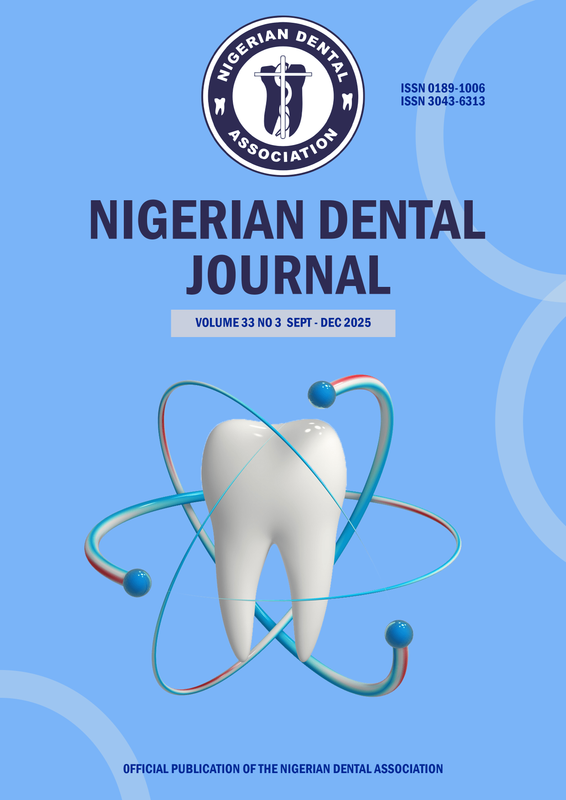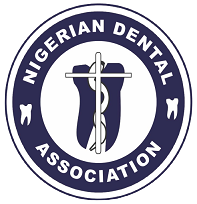Influence of Digit Sucking Habit on Masseter Muscle Thickness and Upper Airway Dimensions in Nigerian Children
Digit Sucking and Masseter Muscle Thickness and Upper Airway Dimensions
DOI:
https://doi.org/10.61172/ndj.v31i2.255Keywords:
Digit Sucking, Upper Airway Dimension, Masseter MuscleAbstract
Background: Digit sucking habit (DSH) generates functional forces that can influence craniofacial morphology. Although the dental effects have been widely reported, its influence on the masseter muscle thickness (MMT) and upper airway (UA) dimensions is not well known.
Methods: Thirty (30) children selected from the orthodontic clinic (OAUTHC), with a DSH were matched with a group of 30 children without a DSH. Each group comprised of 16 males and 14 females. Ultrasonographic evaluation of the masseter muscle (MM) was performed to measure the left and right MMT in the relaxed and contracted states. Lateral cephalometric radiographs were obtained and 6 UA variables were measured on the x-ray. Data was analysed using SPSS version 20.0. Statistical significance was set at p<0.05.
Inferential statistics was done using independent sample t test to compare means.
Results: Participants in the DS group had a mean age of 7.7 ± 2.2 years, whereas those in the non-DS group had a mean age of 8.1 ± 2.1 years. The MM was generally thicker among the DS group, both in the contracted and relaxed states when compared with the non-DS group, but these differences were not statistically significant (p>0.05). The mean measurement of the width of the nasopharynx (P1) was significantly decreased among the DS group when compared with the non-DS group (p<0.05). There was no statistically significant difference in the mean values for the width of the oropharynx (P2), hypopharynx (P3), soft palate length (PNS-U1) and thickness (MPT) and the posterior bony boundary of the nasopharynx (PNS-Ba) between both groups. (p>0.05).
Conclusion: Digit sucking habit caused a statistically significant narrowing of the width of the nasopharynx (p<0.05). The MMT did not differ significantly between the DS and non-DS groups both in the relaxed and contracted states.
Downloads
References
Shah A, Batra M, Sudeep C, Gupta M, Kumar R. Oral habits and their implications. Ann Med 2014;1(04):179-86.
Castelo PM, Gavião MBD, Pereira LJ, Bonjardim LR. Maximal bite force, facial morphology and sucking habits in young children with functional posterior crossbite. J Appl Oral Sci 2010;18(2):143-48.
Shetty RM, Shetty M, Shetty NS, Deoghare A. Three-Alarm System: Revisited to treat Thumb-sucking Habit. Int J Clin Pediatr Dent 2015;8(1):82.
D'Onofrio L. Oral dysfunction as a cause of malocclusion. Orthodontics & craniofacial research 2019;22:43-48.
Yamaguchi H, Sueishi K. Malocclusion associated with abnormal posture. Bull Tokyo Dent Coll 2003;44(2):43-54.
Woodside DG, Linder-Aronson S, Lundström A, McWilliam J. Mandibular and maxillary growth after changed mode of breathing. Am J Orthod Dentofacial Orthop 1991;100(1):1-18.
McNamara Jr JA. Influence of respiratory pattern on craniofacial growth. Ang Orthod 1981;51(4):269-300.
Song H-G, Pae E-K. Changes in orofacial muscle activity in response to changes in respiratory resistance. Am J Orthod Dentofacial Orthop 2001;119(4):436-42.
Kirjavainen M, Kirjavainen T. Upper airway dimensions in Class II malocclusion: effects of headgear treatment. Ang Orthod 2007;77(6):1046-53.
Sahoo NK, Jayan B, Ramakrishna N, Chopra SS, Kochar G. Evaluation of upper airway dimensional changes and hyoid position following mandibular advancement in patients with skeletal class II malocclusion. J Craniofac Surg 2012;23(6):e623-7.
Warren D. Effect of airway obstruction upon facial growth. Otolaryngol Clin North Am 1990;23(4):699-712.
Pirilä-Parkkinen K, Löppönen H, Nieminen P, et al. Validity of upper airway assessment in children: a clinical, cephalometric, and MRI study. Ang Orthod 2011;81(3):433-39.
Salaza-Arboleda. Comparison of the upper airways from cephalometric radiographs of children with and without digit sucking habit. Eur J Paediatr Dent 2014;15(3):326-31.
Corcoran NM, Goldman EM. Anatomy, head and neck, masseter muscle. 2019.
Kiliaridis S. Masticatory muscle influence on craniofacial growth. Acta Odontol Scand 1995;53(3):196-202.
Prasad M, Hussain MZ, Shetty SK, et al. Median mandibular flexure at different mouth opening and its relation to different facial types: a prospective clinical study. J Nat Sci Biol Med 2013;4(2):426-30.
Abigail OS, Olayinka OD, Adebanke KK, Oluwole AO. Relationship between masseter muscle thickness and overbite values in a Nigerian population. Braz J Oral Sci 2017;16:1-10.
Charalampidou M, Kjellberg H, Georgiakaki I, Kiliaridis S. Masseter muscle thickness and mechanical advantage in relation to vertical craniofacial morphology in children. Acta Odontol Scand 2008;66(1):23-30.
Agnihotri A, Magu S, Dutta S. M-mode echomyography: functional assessment of the effects of thumb-sucking habit on masticatory and circumoral musculature. Oral Radiol 2010;26(2):71-76.
Otaren J. Assessment of the effects of digit sucking habit on the masticatory and circumoral musculature using motion mode ultrasonography [FWACS Thesis]: University of Benin Teaching Hospital, Benin City, Nigeria.; 2018.
Baril C, Moyers RE. An electromyographic analysis of the temporalis muscles and certain facial muscles in thumb-and finger-sucking patients. J Dent Res. 1960;39(3):536-53.
Ogden CL, Kuczmarski RJ, Flegal KM, et al. Centers for Disease Control and Prevention 2000 growth charts for the United States: improvements to the 1977 Nat Cen Health Stat Pediatr 2002;109(1):45-60.
Kiliaridis S, Kälebo P. Masseter muscle thickness measured by ultrasonography and its relation to facial morphology. J Dent Res. 1991;70(9):1262-65.
Satiroglu F, Arun T, Isik F. Comparative data on facial morphology and masseter muscle thickness using ultrasonography. Eur J Orthod 2005;27:562–67
Kiliaridis S, Kälebo P. Masseter muscle thickness measured by ultrasonography and its relation to facial morphology. J Dent Res 1991;70:1262–65
Benington PC, Gardener JE, Hunt NP. Masseter muscle volume measured using ultrasonography and its relationship with facial morphology. Eur J Orthod 1999;21:659-70
Serra MD, Gaviao MBD, Uchoa M N D S. The use of ultrasound in the investigation of the muscles of mastication Ultrasound in Med. & Biol. 2008;34:1875-84.
Chopra A, Lakhanpal M, Singh V, et al. The habit of digit sucking among children and the attitude of mother’s towards the habit in India.
Baalack I-B, Frisk A-K. Finger-Sucking in Children A Study of Incidence and Occlusal Conditions. Acta Odontol Scand 1971;29(5):499-512.
Curzon M. Dental implications of thumb-sucking. Pediatr 1974;54(2):196-200.
Quashie-Williams R, daCosta OO, Isiekwe MC. Oral habits, prevalence and effects on occlusion of 4-15 year old school children in Lagos, Nigeria. Niger Postgrad Med J 2010;17(2):113-7.
Larsson E. Dummy-and finger-sucking habits with special attention to their significance for facial growth and occlusion. 1. Incidence study. Svensk tandläkare tidskrift. Swed Dent J 1971;64(10):667.
Grippaudo C, Paolantonio E, Antonini G, et al. Association between oral habits, mouth breathing and malocclusion. Acta Otorhinolaryngol Ital 2016;36(5):386.
Palmer B. Snoring and sleep apnoea: how it can be prevented in childhood. Breastfeeding Review 2006;14(2):11.
Lévy P, Kohler M, McNicholas WT, et al. Obstructive sleep apnoea syndrome. Nat Rev Dis Primers 2015;1:15015.
McNamara JA. A method of cephalometric evaluation. Am J Orthod 1984;86(6):449-69.
Aloufi F, Preston CB, Zawawi KH. Changes in the upper and lower pharyngeal airway spaces associated with rapid maxillary expansion. ISRN Dent 2012;2012.
Downloads
Published
Issue
Section
License
Copyright (c) 2023 Ada Njokanma, Prof Olayinka Donald Otuyemi, Prof. Kikelomo Adebanke Kolawole

This work is licensed under a Creative Commons Attribution 4.0 International License.
Open Access Statement
- We became fully Open Access since January 2023.
- Our new and archived materials are available free of charge on open basis and under a Creative Commons license as stated below.
Copyright statement
Copyright © 1999 The authors. This work, Nigerian Dental Journal by Nigerian Dental Association is licensed under Creative Commons Attribution 4.0 International License.

